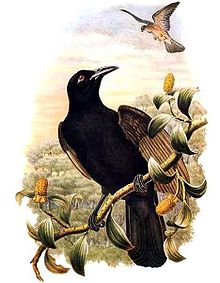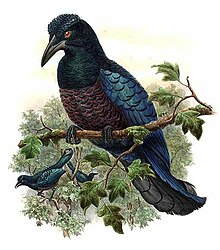Phonygamminae
| Phonygamminae | ||||||||||||
|---|---|---|---|---|---|---|---|---|---|---|---|---|

Sonic manucodes, depicted by Richard Bowdler Sharpe |
||||||||||||
| Systematics | ||||||||||||
|
||||||||||||
| Scientific name | ||||||||||||
| Phonygamminae | ||||||||||||
| GR Gray , 1846 |
Phonygamminae is a subfamily of the birds of paradise (Paradisaeidae) and is therefore one of the passerine birds (Passeriformes). The seven species of this subfamily, which are divided into three genera, occur mainly in New Guinea and adjacent islands and archipelagos . Two species are limited in their distribution to the Moluccas and another species, the Curly Paradise Crow , is endemic to the D'Entrecasteaux Islands and the Trobriand Islands east of Papua New Guinea . The species with the largest range is the Sonic Manucodia . It stretches from Vogelkop in the far west of New Guinea to the D'Entrecasteaux Islands in eastern New Guinea and the Australian Cape York Peninsula . Compared to all birds of paradise, it has the largest range. Their way of life is more intensely researched compared to the other species of the subfamily. For the other species, numerous details of nutrition and reproductive biology have not yet been clarified.
features
The species of the subfamily Phonygamminae differ from the other birds of paradise mainly by their crow-like appearance, which is also reflected in the frequent use of "crow" in the German trivial names. Their plumage is predominantly blue-black and has a strong iridescent sheen. They reach a body length between 34 and 43 centimeters. The crowded paradise crow is the heaviest and largest of the seven species and weighs between 410 and 440 grams. The females are usually slightly smaller than the males. The sexual dimorphism is not very pronounced - in some species the plumage of the females shines in a slightly different tone than that of the males.
The individual species have a very similar appearance. In particular, the species belonging to the manukodes cannot usually be distinguished in field observations where they overlap in their distribution area. The feathers above the eye are slightly elongated and very dense, they form a noticeable "eyebrow" in some species. The plumage of all species is very shiny. The metallic iridescent sheen ranges from blue-green to bronze colors. In certain lighting conditions, magenta-colored highlights are also formed. The beak is at least as long as the head and can be up to three centimeters longer than the head. The beak ridge is slightly raised and broadened. This trait is least developed in the Jobi paradise crow . The tail plumage is long and corresponds to 81 to 84% of the wing length. It is graded in all species, this gradation is least clearly developed in the Jobiparadiescrahe. The tarsus, on the other hand, is comparatively short with a length of 21 to 22 percent of the wing length.
The Manukoden species and the Schall Manucodia have an elongated trachea in the males as an anatomical feature. It lies in loops over the chest muscles and directly under the skin of the chest. Frith and Beehler suspect that this elongated windpipe, which is very unusual for songbirds, has the function of lowering the pitch of the males' calls and thus ensuring that they can be heard from afar. This feature is absent in the Lycocorax species, but the skull structure is similar to that of the Manukodes.
Way of life
The species of the subfamily Phonygamminae live predominantly solitary or in pairs. Only in the case of the Schall-Manucodia are small groups of conspecifics formed more often. While foraging for food, the other species are occasionally associated with other songbird species, while the sonic manucodia shows a high level of aggression towards competitors for food. When socializing with other species, at least the Jobiparadise crow and the Green Paradise crow show a preference for bird species where the plumage is dominated by brown or black.
The diet consists mainly of fruits, which are believed to be eaten by all species, as well as invertebrates. The role of animal food in their diet has not yet been conclusively investigated. The brilliant paradise crow, however, has already been observed killing a pearl-wing monarch ( Monarcha guttural ) caught in a Japanese net and eating his brain.
Reproduction
The species in this subfamily are monogamous birds. They build their nests high up in the treetop in forks of branches and mainly use parts of creepers for construction. For all the species that have been studied in more detail so far, the clutch consists of one or two eggs. The basic color of the eggs in all species is a pink shade, with gray, purple or blackish spots on the shell. Only in the Schall-Manucodia are dashes instead of spots as they are typical for the other subfamily of the birds of paradise, the actual birds of paradise . In several species, both parent birds are involved in the breeding business.
species
The following species belong to the subfamily Phonygamminae:
-
Lycocorax - 2 types
- Crow bird of paradise ( Lycocorax pyrrhopterus )
- Obi paradise crow ( Lycocorax obiensis )
-
Manukodes ( Manucodia ) - 5 species
- Bright Paradise Crow ( Manucodia ater )
- Green Paradise Crow ( Manucodia chalybatus )
- Ruffle Paradise Crow ( Manucodia comrii )
- Jobi Paradise Crow ( Manucodia jobiensis )
-
Phonygammus - 1 type
- Sonic Manucodia ( Phonygammus keraudrenii )
The obi paradise crow has only recently been classified as a separate species. The Schall-Manucodia was considered a type of Manukod for a long time before it was placed in an independent genus.
Trivia
The bright paradise crow is the first bird of paradise that a European, René-Primevère Lesson, observed in the wild.
literature
- Bruce M. Beehler , Thane K. Pratt: Birds of New Guinea; Distribution, Taxonomy, and Systematics . Princeton University Press, Princeton 2016, ISBN 978-0-691-16424-3 .
- Clifford B. Frith, Bruce M. Beehler : The Birds of Paradise - Paradisaeidae . Oxford University Press, Oxford 1998, ISBN 0-19-854853-2 .
Single receipts
- ↑ Frith & Beehler: The Birds of Paradise - Paradisaeidae. P. 230.
- ↑ C. Frith, D. Frith: Curl-crested Manucode (Manucodia comrii). In: del Hoyo, J., Elliott, A., Sargatal, J., Christie, DA & de Juana, E. (eds.). Handbook of the Birds of the World Alive. 2017. Lynx Edicions, Barcelona. ( Online , accessed July 9, 2017)
- ↑ Frith & Beehler: The Birds of Paradise - Paradisaeidae. P. 217.
- ↑ a b c Frith & Beehler: The Birds of Paradise - Paradisaeidae. P. 211.
- ↑ Frith & Beehler: The Birds of Paradise - Paradisaeidae. P. 204.
- ↑ Frith & Beehler: The Birds of Paradise - Paradisaeidae. P. 205.
- ↑ Frith & Beehler: The Birds of Paradise - Paradisaeidae. P. 206.
- ↑ Frith & Beehler: The Birds of Paradise - Paradisaeidae . P. 223.
- ↑ Frith & Beehler: The Birds of Paradise - Paradisaeidae. P. 220.
- ↑ Frith & Beehler: The Birds of Paradise - Paradisaeidae. P. 215.
- ↑ Frith & Beehler: The Birds of Paradise - Paradisaeidae. P. 239.
- ↑ a b Handbook of the Birds of the World on Obiparadieskrähe , accessed on July 3, 2017
- ↑ Frith & Beehler: The Birds of Paradise - Paradisaeidae. P. 212.

